

Resurse. TOP. 50 Top Sources Of Free eLearning Courses. Whether you are looking for a master’s degree program, computer science classes, a K-12 curriculum, or GED study program, this list gives you a look at 50 websites that promise education for free.
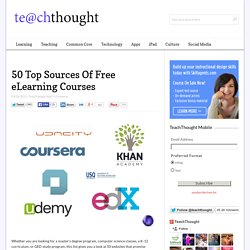
From databases that organize over 1,000,000 students throughout 16 universities, to a small library of documents for those interested in history, the opportunities for free online learning continue to expand as the Internet becomes a crucial component in education. 1. UMass Boston Open Courseware The UMass courseware offers a broad range of classes in areas like psychology, biology, early education, political science, history, mathematics, and others. Each department has a separate page listing the classes available. There are no slides, videos, or lecture notes, which makes this open courseware inferior to other universities that offer extensive resources. 2. This website has a variety of video lessons for free. 3. 4. 5. 6. 7. 8. Stanford on iTunes U gives you two options. 9. 10. 11. 12. 13. 50 big ideas to change L and D.
Can Online Learning be as Effective as Classroom Learning? In 2103, Ed4Online launched the first in our series of ‘In Your Opinion’ polls.
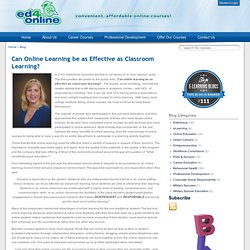
The first question we posed to the public was, “Can online learning be as effective as classroom learning?” The results, while revealing, mirrored the heated debate that is still taking place in academic circles – with 68% of respondents indicating “Yes, it can be” and 32% having serious reservations and even outright hostility to the concept of online learning. With many more college students taking online courses, we must continue to have these discussions. 3 Strategies that Build Long-Term Memory in Corporate Learners. If your corporate learners forget what they learned right after training, were they even trained at all?
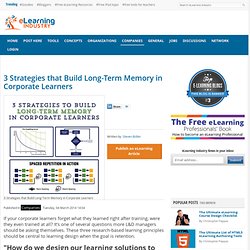
It’s one of several questions more L&D managers should be asking themselves. These three research-based learning principles should be central to learning design when the goal is retention. The reality is that most formal training fails to meet its business objectives. Whether the organization is looking for more sales, less support calls, fewer accidents, or other measurable goals, training can only go so far if the learning value is quickly lost. The E-Learning Department of One: Four Survival Skills Needed to Succeed.
The E-Learning Department of One: Four Survival Skills Needed to Succeed Most existing guidelines for eLearning planning and implementation are designed with larger organizations in mind and assume a level of staffing, IT support, and budget because traditionally large corporations are the ones with sufficient resources to create eLearning solutions.

However, eLearning is rapidly growing in small companies and nonprofit organizations, where typically a single person is responsible for all eLearning activities — in other words, an eLearning department of one. A one-man eLearning department must be highly talented and possess a combination of skill sets: he or she should know how to use authoring tools, design, and give a great voice to content. In other words, a one-man eLearning professional needs to be a programmer, project manager, graphic artist, and media specialist all rolled into one. 1. To ensure you do not make any of these mistakes, check out these free resources: 2. 3. Does Your eLearning Have too Much Content? One of the most common criticisms of eLearning is that it contains too. much. content.
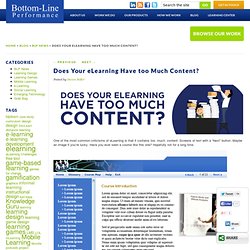
Screens of text with a “Next” button. Maybe an image if you’re lucky. This Week's Best eLearning News and Articles (Issue 25)
Instructional design. eLearning Newsletter Issue #25 This week’s best e-Learning articles. Video tools. Zaption - Interactive Video for Learning. Five-Minute Film Festival: 8 Interactive Video Tools for Engaging Learners. Gamification. E-Learning Instructional Design Certificate Program. Building skills in developing and delivering online learning are integral to addressing the task of training online.
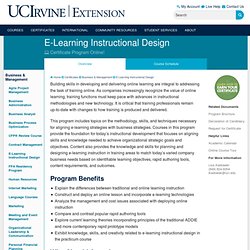
As companies increasingly recognize the value of online learning, training functions must keep pace with advances in instructional methodologies and new technology. It is critical that training professionals remain up-to-date with changes to how training is produced and delivered. This program includes topics on the methodology, skills, and techniques necessary for aligning e-learning strategies with business strategies.
Make the Most of SME Interview Time! by Michele Medved. “By using these tips to plan, conduct, and follow up on your meeting you can achieve your project goal in a timely and effective manner.”

Your time with subject matter experts (SMEs) is limited because of their own responsibilities and deadlines. It is important to maximize your time with them so that you get the answers you need, while remaining respectful of their limited time. In this article, I offer ideas I have found useful for planning and doing effective interviews with SMEs. Interactive Scenario. 5 Instructional Design Fundamentals – Simplified. Instructional Design (ID), simply stated, focuses on enhancing learning.
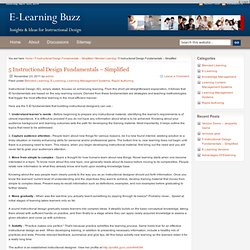
From this short yet straightforward explanation, it follows that ID fundamentals are based on the way learning occurs. Derived from these fundamentals are strategies and teaching methodologies that trigger the most effective learning in the most efficient manner. Here are the 5 ID fundamentals that budding instructional designers can use - 1. Understand learner's needs - Before beginning to prepare any instructional material, identifying the learner's requirements is of utmost importance. 2. 3.
Knowing about the way people learn clearly points to the way you as an instructional designer should put forth information. Directions by Jane Bozarth. “Sometimes, in designing eLearning, another thing happens: we get so caught up in the ‘look and feel’ and aesthetics that we miss the obvious.

And sometimes we make it so hard for learners to learn, it’s no wonder they circumvent us.” I’m lucky to get to speak in London every now and again. As I’m usually staying in whatever part of town is closest to the particular event, I am often in an unfamiliar area.
Essential Reading for Instructional Design? As an instructional designer/eLearning professional, what books are the essential tools in your reference library?
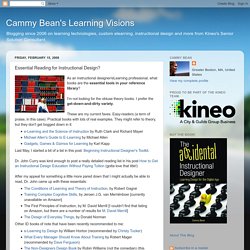
I'm not looking for the obtuse theory books. I prefer the get-down-and-dirty variety. These are my current faves. Easy-readers (a term of praise, in this case). Practical books with lots of real examples. Last May, I started a bit of a list in this post: Beginning Instructional Designer's Toolkit. Dr. Free eLearning and Instructional Design Books.
TTS. Storyboarding. Adobe Captivate. The Planet's Most Awesome eLearning Template Library! 80+ Course Authoring Tools. A Practical Guide to the Top 100 Tools for Learning 2013: Contents. Centre for Learning & Performance Technologies. The 5 Best Free Mind-Mapping Tools for Teachers. Skills Gap Assessment. Identify and Address Skills Gaps. Optimize Your Team's Performance. Based on ASTD’s Competency Model, the Career Navigator enables you to create an actionable plan that identifies skills gaps and recommendation on how to close them.
Our new, enhanced Career Navigator tool features an Enterprise version that can aggregate 180-degree assessment results for your whole team. Key Features of the Enterprise Version of the Career Navigator: Functionality that empowers your team to self-assess with the option to include their manager in the 180 assessment process. Final Report Sample Optimize your team’s capabilities with the ASTD Career Navigator. The Free eBook: How to become an eLearning Professional. By Connie Malamed I never think of myself as an expert. Gaining expertise is an ongoing journey of continuous learning where there is no end in sight. Our field is particularly broad and deep.
It encompasses aspects of cognitive science, learning theory, user experience, design thinking, human communication, user interface design, visual design, writing and scripting, marketing, business, information technology and probably many other domains. The Free eBook: How to become an eLearning Professional. 23 eLearning Experts Help You Become a Top-Notch eLearning Professional! The Free How to Become an eLearning Professional eBook is filled with the knowledge, wisdom, experience and inspiration of carefully selected eLearning professionals.
Making Video More Social by Jane Bozarth. “Next time you’re working with deploying video online, step back and look for ways to help learners engage with it—and with each other—rather than only consume it.” Since the first filmstrip projector made its way into the first classroom, standup trainers have been incorporating video into formal instruction. In my experience, most actually do this pretty well: I’ve seen good use throughout my career of relevant video clips, points for discussion, and some conversation about what and why and comparison to that. Video often made for good conversation and could reach the affective domain when other approaches did not. But when we moved to eLearning we left a lot of that behind—the video clips were part of the eLearning content, but the rest of that experience, the talking and processing, didn’t make the transition. 10 Enlightening Pearls of Wisdom for eLearning Professionals [SlideShare]
5 Ways to Reduce Cognitive Load in eLearning. The information processing capacity of learners is limited, so it's important that designers take this into account when creating eLearning courses. 4 reasons why eLearning should never be compulsory (and 4 great alternatives) Need To Make More Content, Faster? Try Quick Learning Modules. 5 Red Flags That Show Your e-Learning Course Will Fail. How to Find Free Stock Photos & Clip Art for PowerPoint. I was leading a PowerPoint workshop last week and noticed that Microsoft recently changed the way images are searched on their site.
The Millennials Are Coming! Proven Engagement Strategies by Elisabeth Arellano. 10 Inspiring SlideShare Presentations Every eLearning Professional Should See. Three Simple Cooperative Learning Activities You Should Try. This is our fourth and final post in a series on cooperative learning. ‘RFP’ Woes and How to Get the E-Learning Solution of Your Dreams. Don't Blame Your Content by Jane Bozarth. 68 Tips for eLearning Engagement and Interactivity - Thank You Success Page. eLearning: Key Industry Trends in 2013. 68 Tips for eLearning Engagement and Interactivity.
Marc My Words: Don't Dismiss Level One Evaluation by Marc J. Rosenberg. Crooked Lines by Jane Bozarth. Crooked Lines by Jane Bozarth. Don't Blame Your Content by Jane Bozarth. 8 Effective Scenario Ideas for Instructional Designers - eLearning Brothers. Daniel Goleman on the Importance of Cultivating Focus (Video Playlist) The Holy Trinity of Effective eLearning: Usability, Utility and Desirability.
Articulate Storyline vs Adobe Captivate. My Wish Lists for Articulate Storyline and Adobe Captivate. 7 reasons why the new Articulate Storyline is a Game-Changer for eLearning. Adobe Captivate 6 Vs Articulate Storyline. Shine on the web.